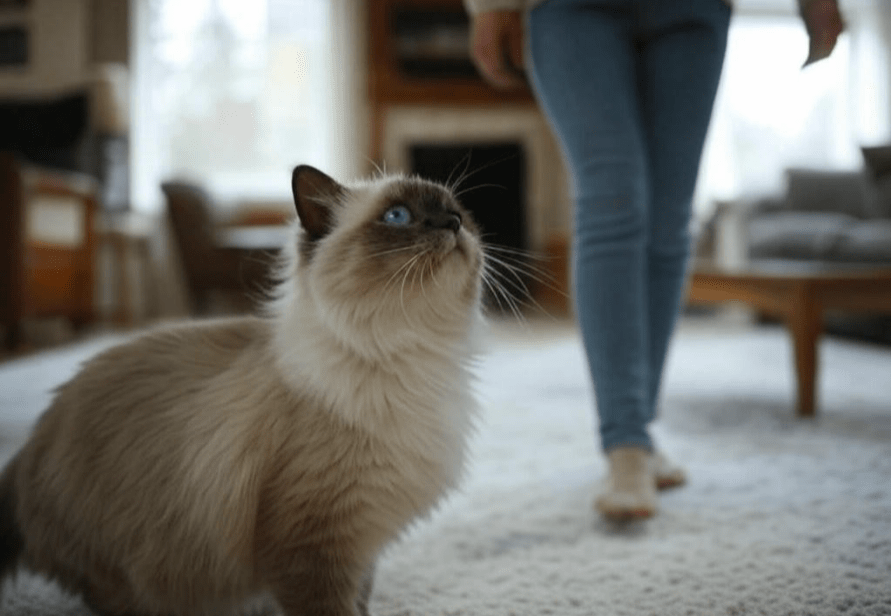
Ragdoll cats are beloved for their docile, affectionate nature and stunning appearance, but like any pet, they can sometimes develop behaviors that puzzle their owners. If your Ragdoll cat stops using the litter box, it can be frustrating and concerning. This issue, often referred to as inappropriate elimination, is not uncommon, but it’s rarely a simple matter of defiance. Understanding why your Ragdoll is avoiding the litter box and addressing the root cause is key to resolving the problem. In this comprehensive guide, we’ll explore the potential reasons behind this behavior, actionable solutions, and preventative tips to ensure your Ragdoll feels comfortable using their litter box again.
Why Is My Ragdoll Cat Not Using the Litter Box?
When a Ragdoll cat stops using the litter box, it’s often a sign of an underlying issue rather than a behavioral quirk. Cats are naturally clean animals, and Ragdolls, known for their gentle temperament, are no exception. Here are the primary reasons why your Ragdoll may be avoiding the litter box:
1. Medical Issues
Health problems are one of the most common causes of litter box avoidance in Ragdoll cats. Pain or discomfort during urination or defecation can lead your cat to associate the litter box with negative experiences. Common medical issues include:
Urinary Tract Infections (UTIs): UTIs can cause frequent, painful urination, leading your Ragdoll to avoid the litter box.
Bladder Stones or Crystals: These can cause blockages or irritation, making urination difficult.
Kidney Disease: Ragdolls are prone to kidney issues, which can alter urination habits.
Arthritis or Mobility Issues: Older Ragdolls may struggle to access high-sided litter boxes due to joint pain.
Gastrointestinal Issues: Constipation or diarrhea can make defecation uncomfortable.
What to Do: Schedule a vet visit immediately if your Ragdoll stops using the litter box. A thorough examination, including urine and blood tests, can identify or rule out medical conditions. Early intervention is critical, especially for conditions like UTIs or blockages, which can be life-threatening if untreated.
2. Stress or Anxiety
Ragdolls are sensitive to changes in their environment, and stress can trigger litter box avoidance. Common stressors include:
Household Changes: Moving to a new home, introducing a new pet, or adding a family member can unsettle your Ragdoll.
Litter Box Competition: In multi-cat households, your Ragdoll may feel intimidated by another cat using the same litter box.
Loud Noises or Disruptions: Construction, loud music, or frequent visitors can make your cat feel unsafe.
What to Do: Identify and minimize stressors. Provide a quiet, safe space for your Ragdoll with easy access to their litter box. Consider using pheromone diffusers like Feliway to reduce anxiety. If you have multiple cats, ensure there are enough litter boxes (one per cat plus one extra) to prevent competition.
3. Litter Box Issues
Your Ragdoll may avoid the litter box if it’s not meeting their preferences. Common litter box problems include:
Dirty Litter Box: Ragdolls are fastidious and may refuse to use a soiled box.
Litter Type: A sudden change in litter brand or type (e.g., from clumping to non-clumping) can deter your cat.
Box Size or Design: A box that’s too small, covered, or high-sided may be uncomfortable, especially for larger Ragdolls.
Location: If the litter box is in a noisy, high-traffic area, your Ragdoll may feel exposed.
What to Do: Keep the litter box clean by scooping daily and changing the litter weekly. Experiment with different litter types to find one your Ragdoll prefers (many Ragdolls like unscented, clumping litter). Ensure the box is large enough—Ragdolls are big cats and need spacious boxes. Place the litter box in a quiet, low-traffic area with easy access.
4. Behavioral or Territorial Issues
Ragdolls may stop using the litter box to mark their territory or communicate dissatisfaction. This is more common in unneutered or unspayed cats but can occur in neutered cats too. Behavioral issues might include:

Spraying or Marking: Your Ragdoll may urinate outside the box to mark territory, especially in multi-pet households.
Dislike of Shared Boxes: Some Ragdolls prefer exclusive access to their litter box.
What to Do: If your Ragdoll isn’t spayed or neutered, consult your vet about the procedure, as it can reduce marking behaviors. In multi-pet homes, provide separate litter boxes in different locations to prevent territorial disputes. Positive reinforcement, like treats or praise for using the litter box, can encourage good habits.
5. Environmental Preferences
Ragdolls are particular about their surroundings. Subtle changes, like a new cleaning product with a strong scent or a rearranged room, can make the litter box less appealing.
What to Do: Avoid using heavily scented cleaning products near the litter box. Maintain a consistent environment around the box to make your Ragdoll feel secure.
Step-by-Step Solutions for Ragdoll Litter Box Problems
Once you’ve identified the potential cause, follow these steps to encourage your Ragdoll to resume using the litter box:
Step 1: Rule Out Medical Issues
Visit your veterinarian to diagnose and treat any health problems. Follow their recommendations for medication, dietary changes, or follow-up care. For example, if your Ragdoll has a UTI, antibiotics and increased water intake can resolve the issue.
Step 2: Optimize the Litter Box Setup
Make the litter box as inviting as possible:
Cleanliness: Scoop daily and deep-clean the box monthly with mild, unscented soap.
Litter Choice: Use a fine, unscented, clumping litter, as many Ragdolls prefer this texture.
Box Size: Choose a large, low-sided box for easy access, especially for senior Ragdolls.
Location: Place the box in a quiet, private area away from food and water bowls.
Multiple Boxes: In multi-cat homes, provide one box per cat plus one extra, ideally in different locations.
Step 3: Address Stress and Anxiety
Create a calm environment for your Ragdoll:
Safe Spaces: Provide hiding spots, perches, or a cozy bed where your cat can retreat.
Pheromone Therapy: Use Feliway diffusers or sprays to reduce stress.
Routine: Stick to a consistent feeding, play, and cleaning schedule to give your Ragdoll a sense of security.
Step 4: Retrain Your Ragdoll
If your Ragdoll has developed a habit of eliminating outside the box, retraining may be necessary:
Confinement: Temporarily confine your Ragdoll to a small, quiet room with their litter box, food, water, and bedding. This encourages them to use the box consistently.
Positive Reinforcement: Reward your Ragdoll with treats, praise, or playtime when they use the litter box.
Clean Accidents Thoroughly: Use an enzymatic cleaner to remove the scent of urine or feces from areas where your cat has eliminated. This prevents them from returning to the same spot.
Step 5: Monitor and Adjust
Track your Ragdoll’s progress over a few weeks. If the problem persists, revisit the vet or consult a feline behaviorist. Be patient—resolving litter box issues can take time, especially if stress or medical conditions are involved.
Preventing Future Litter Box Problems
Prevention is easier than correction. Here are proactive steps to keep your Ragdoll using the litter box consistently:
1. Maintain a Clean Litter Box
Scoop daily, change the litter weekly, and deep-clean the box monthly. A clean box is more inviting and reduces the risk of avoidance.
2. Regular Vet Checkups
Schedule annual or biannual vet visits to catch health issues early. Ragdolls are prone to kidney and urinary problems, so routine urine tests can be beneficial.
3. Provide Enrichment
Boredom or lack of stimulation can contribute to stress. Offer toys, scratching posts, and interactive playtime to keep your Ragdoll mentally and physically engaged.
4. Monitor Environmental Changes
Introduce changes gradually, whether it’s a new pet, furniture, or litter brand. Watch for signs of stress, like hiding or reduced appetite, and address them promptly.
5. Choose the Right Litter Box
Invest in a high-quality, spacious litter box designed for large breeds like Ragdolls. Consider open boxes for better ventilation and accessibility.
Common Mistakes to Avoid
When addressing litter box issues, steer clear of these pitfalls:

Punishing Your Ragdoll: Yelling or punishing your cat for accidents can increase stress and worsen the problem.
Ignoring Medical Issues: Assuming the issue is purely behavioral can delay treatment for serious health conditions.
Using Scented Litter or Cleaners: Strong smells can deter Ragdolls from using the box.
Placing the Box in a Busy Area: High-traffic locations can make your cat feel vulnerable.
Changing Litter Brands Abruptly: Transition to new litter gradually to avoid rejection.
When to Seek Professional Help
If you’ve tried the above solutions and your Ragdoll still avoids the litter box, it’s time to seek expert assistance:
Veterinarian: A vet can perform advanced diagnostics, like X-rays or ultrasounds, to uncover hidden health issues.
Feline Behaviorist: A certified cat behaviorist can assess your Ragdoll’s environment and behavior to create a tailored plan.
Board-Certified Veterinary Behaviorist: For complex cases involving anxiety or aggression, a veterinary behaviorist can prescribe medications or therapies.
Understanding Ragdoll-Specific Traits
Ragdolls are a unique breed, and their characteristics can influence litter box behavior:
Size: Ragdolls are one of the largest domestic cat breeds, so they need appropriately sized litter boxes.
Sensitivity: Their gentle, people-oriented nature makes them more susceptible to stress from environmental changes.
Health Predispositions: Ragdolls are prone to polycystic kidney disease (PKD) and hypertrophic cardiomyopathy (HCM), which can indirectly affect litter box habits.
Tailoring solutions to your Ragdoll’s needs can make a significant difference in resolving litter box issues.
Additional Tips for Ragdoll Owners
Hydration: Encourage water intake with a pet fountain or wet food to support urinary health.
Diet: Feed a high-quality, balanced diet to prevent digestive issues that could affect litter box use.
Grooming: Regular grooming reduces stress and keeps your Ragdoll comfortable, which can positively impact their behavior.
Conclusion

If your Ragdoll cat stops using the litter box, it’s a signal that something—whether medical, environmental, or behavioral—needs attention. By addressing the root cause, optimizing the litter box setup, and creating a stress-free environment, you can help your Ragdoll return to their clean, consistent habits. Patience, observation, and proactive care are key to resolving this issue and maintaining a happy, healthy relationship with your feline companion.
This guide aims to be the ultimate resource for Ragdoll owners facing litter box challenges. By following these steps and tailoring solutions to your cat’s unique needs, you’ll not only solve the problem but also strengthen the bond with your beloved Ragdoll. If you have further questions or need personalized advice, consult your veterinarian or a feline behavior expert to ensure your Ragdoll thrives.




